SCENTED SEEDS
Madagascar’s vanilla pods of desire
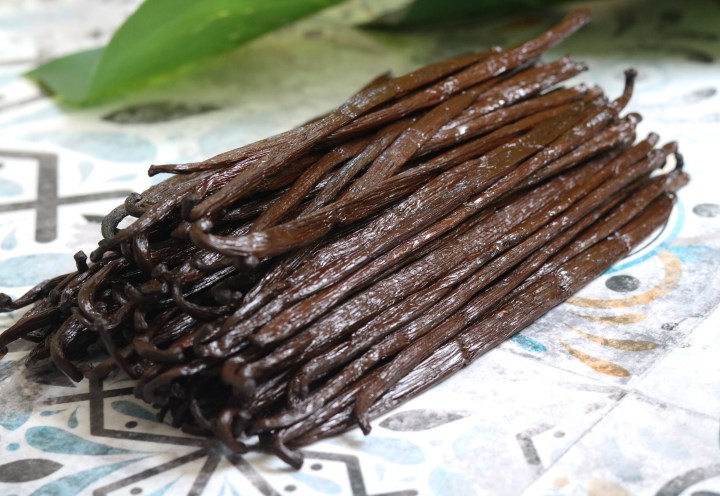
You want the world’s best vanilla. And you want it fresh. When it’s yours, you’ll make something to show it off. That’s how it usually works, even in history. Now there’s a way to get it, directly from Madagascar.
As a kid, the most boring, (the most “vanilla”), ice cream was that plain white one, used when an ice cream was required that wouldn’t fight with the preserved guavas that were for pudding. Maybe even with the custard your sister insisted on as well, thank heavens.
And remember carefully adding that half teaspoon, sometimes just a fewPreview (opens in a new tab) drops, of liquid from the little vanilla essence bottle into cake mix, scone mixture, fudge, pretty much anything you were making on the sweet scale? You wondered why but that’s what you did. It certainly had a smell, quite a nice one, but you wondered if it tasted of anything really in the things it went into.
Funny, now that you think of it and reach back for the memory tastes of that pudding bowl of guavas, the thing that tasted more of vanilla than the vanilla ice cream was the custard.
Then came the time of French vanilla. A lot of things were suddenly French, perhaps for improvement, at least in concept. But when it had to do with ice cream, it was really the ice cream that was supposed to be French, with egg yolks added to it in the French or custard style, at best turning it from fright white to pale cream.

Most of the vanilla from Madagascar is grown by small farmers, the hand pollinated way. (Photo: Supplied)
When it was used to describe the vanilla itself, it was a con, since vanilla is fussy about the degrees latitude (usually between 10 and 20) where it grows and France cannot grow any. However, Madagascar, though no longer in the clutches of France, was often still regarded as being kind of French. The Madagascan vanilla beans are called Bourbon, not for the booze but for the island nearby, Reunion, once called Bourbon. That was where the originally Mexican vanilla beans were first hand-pollinated and established. Madagascar is on the ideal part of the vanilla-growing map and the Bourbon vanilla from there is grown the time-taken, hand-pollinated way, then slowly, coddlesomely cured by experienced hands and that makes an enormous difference to its own special taste. Madagascan vanilla is surely the ultimate Slow Food. Take note there in Bra, Italy.
Small farmers of Madagascar grow the most, and most of the best, of the world’s real vanilla. They do not use mechanised methods.
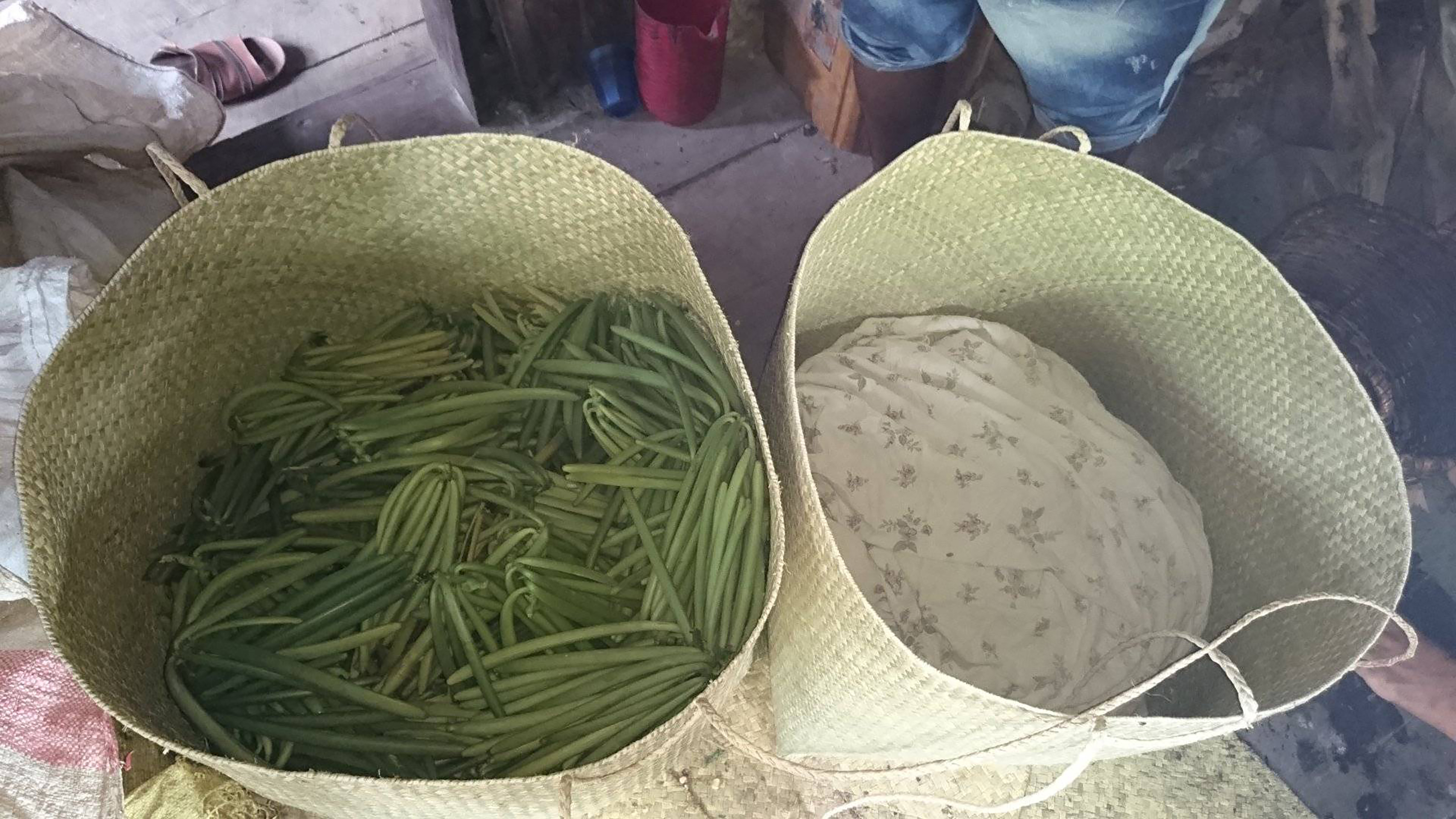
Vanilla pods hand harvested, cured in the sun and coddled in warm, dry blankets. (Photo: Supplied)
My treasured Eden scene was seeing, in the Andasibe rainforest of Madagascar, a greenish boa casually making its way through the verdant undergrowth and my realising that it, like most Madagascan snakes, was harmless. So that was a nice kind of thrill, made glorious by noticing that the snake was at the base of a young, flowering vanilla orchid. All in one visual.
After knowing more about vanilla and it’s not being French, people who made pastries and confectionery, whether they themselves were French or not, became more fussy about using real vanilla. For preference, they’d use seeds scraped from the cured pods and infused into their wares. Those old essences turned out to have been ersatz, replaced by the new extracts, made from actual vanilla. There is vanilla from Mexico, from Uganda, from Tahiti, where there is another type of vanilla entirely, but most of it comes from Madagascar for the reasons mentioned, the chief being taste.
I, like so many other keen cooks, have bought pods or beans in glass tubes and been disappointed by the amount of seeds or “caviar” and the leathery, grey looking, elderly aspect of many pods. From Madagascar I came back with just a plastic shopping bag of freshly cured vanilla pods and stuck them all in a big glass jar that I had for ages on the kitchen counter. Even those, badly kept as they were, surpassed in quality the expensive things I’ve since bought in specialist shops.
Today I am smelling and touching really fresh vanilla. Yes, it’s long-cured before it arrives. It’s also sold in glass tubes but this pod is slickly soft and supple, almost bursting with seeds. This is Madagascan bourbon vanilla and it arrives, every couple of weeks, from the island by DHL, sent by the farmer himself. It’s the first time I’ve smelt really fresh and good vanilla. Even in Madagascar I didn’t really stop to do that. Since then I’ve been nosing it hopefully till today. I’ll never forget the smell of the real best thing now, surprisingly complex with a distinctive signature.
So, though history dictated the development and then the use of vanilla in food, in Nikita Suter’s case it happened the other way around. She was tired of old, badly cured, even brittle vanilla pods being sold to her. She’s fanatically particular about best quality ingredients, for her very classy, one-woman business Haute Cakes. There had to be a better way of getting the stuff.
I have some in my hand. Nikita’s husband, Nico, was holding it a bit like a wand and emptied it into my hand. After lots of search and sourcing from his side, as an IT and financial man, Nico identified most with one of the smallholding vanilla farmers in the forest hills of north Madagascar and started sourcing his pods for Nikita, for her cakes and baking business. What a difference it made, Nikita had raved. If so, was there not a market for other specialist bakers? Other people were importing vanilla pods from many countries, he discovered through researching the market and its supply. He realised he could do it very well by getting the optimum vanilla pods regularly, in their optimum state, fresh, from the farm of this one particular farmer, not a market or through another business.
“It just so happens I love the taste of vanilla too,” says Nico. He’s the husband, and now the importer. That’s lucky, I consider with a smile as vanilla-aroma-laden fresh baking smells swell out of the kitchen.
I love it that the business arose from a real desire for the ingredient, that it’s so simple. There’s a small vanilla farmer, a simple package delivered to Nico’s small study by the fastest route. He simply packages the pods and sends them out as a small online business, Nilla Vanilla, that does only this one thing, vanilla. It’s how I came across this couple.
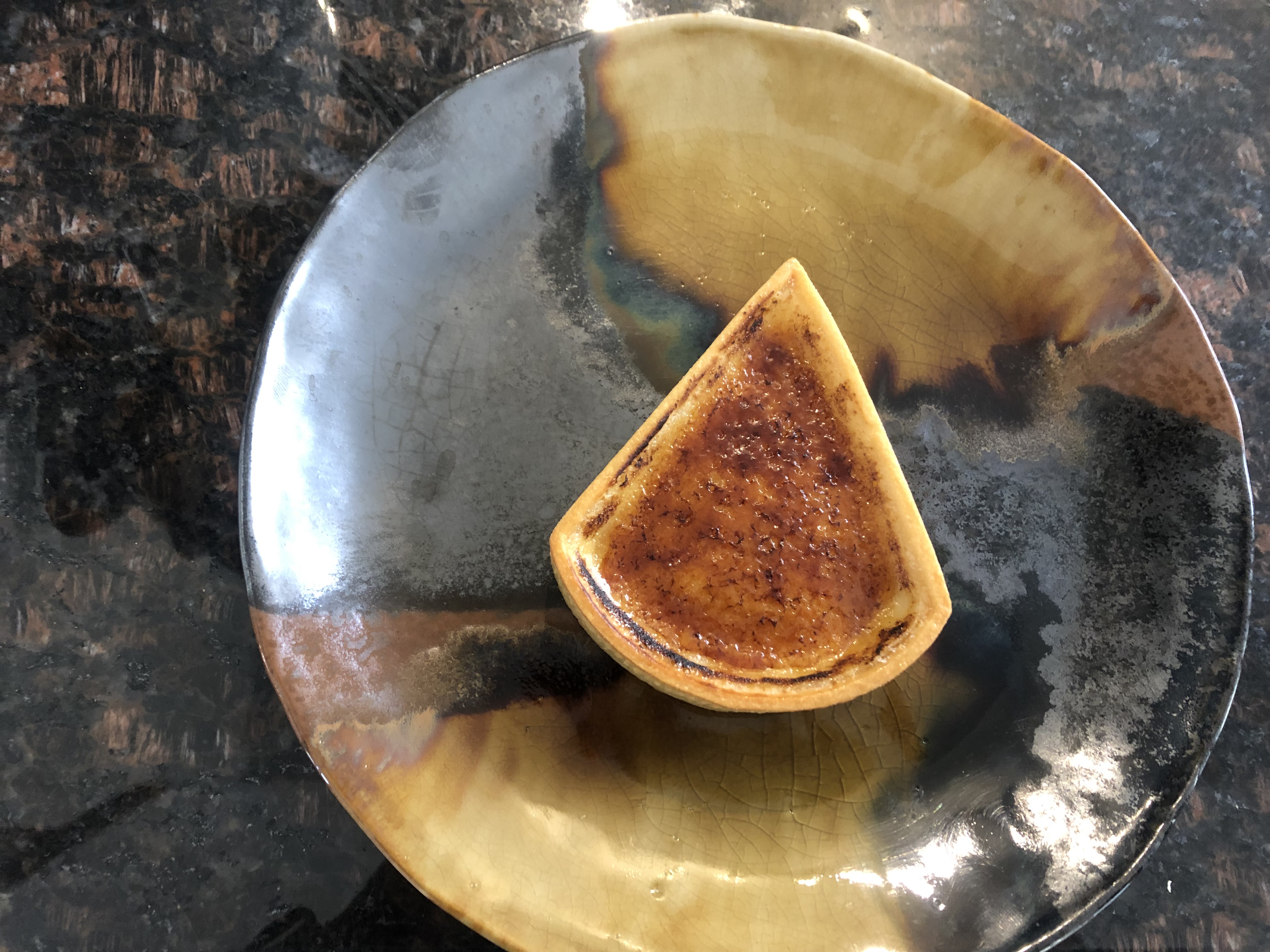
One of my very vanilla crème brûlée pastries. (Photo: Marie-Lais Emond)
With our pour-over coffee, Nico and I each eat a very vanilla crème brûlée pastry each, achingly delicious, the pastry itself too.
We had helped ourselves from a spread on a big glass table. A very pretty cake with tiny rosebuds around it is apparently a carrot cake entramet, so many layers under the prettiness of pecan and yoghurt too, no doubt featuring vanilla.
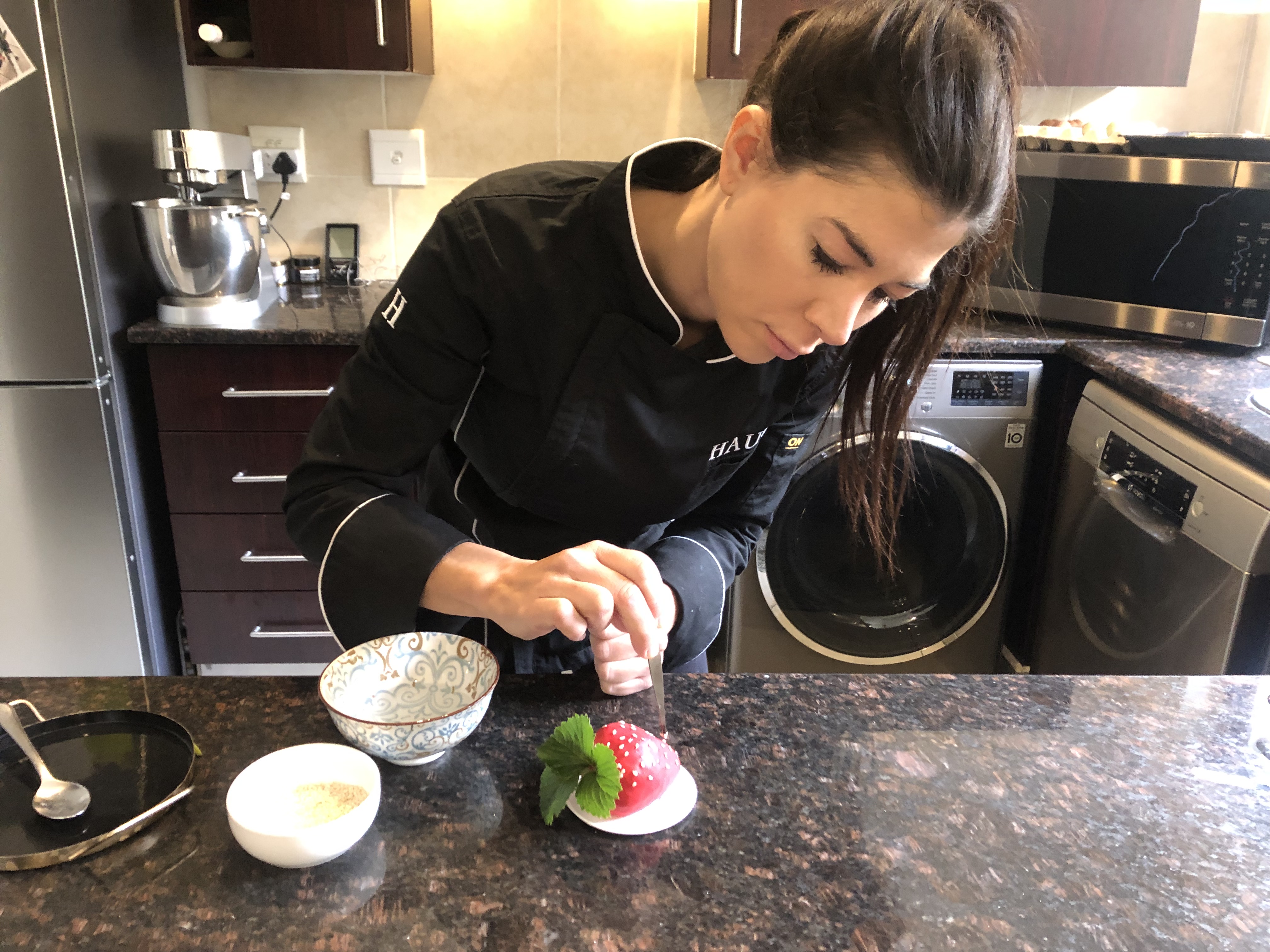
Nikita placing sesame ‘pores’ onto a giant strawberry that is a small gateau. (Photo: Marie-Lais Emond)
“All these things I’ve been making today are specially ones that truly depend on the best vanilla,” says Nikita in a black chef jacket over black lycra fitness leggings. She’s obviously fit, not just from baking. At present, she’s painting the chocolate “pores” on to a giant strawberry that is a confection that’s really a small gâteau of lemon, white Callebeaut chocolate and vanilla bavarois, enclosing vanilla-candied strawberries in a honey reduction
“Now you’ll want to make something that shows the best vanilla off to your family and friends?” I had privately just been thinking of madeleines. I love making them in the funny little tins I’ve collected.
“Have you ever made canelés?”
I’ve never dared. I’ve never considered wrecking my love of them by making anything that might just turn out to be mediocre. I blink. Is this possible? I voice my fears.
“Don’t worry. I know all the tricks, I’ll show you. The first one is using copper moulds. Only copper moulds for canelés.” My heart leaps when she says that the loveliest thing about a canelé de Bordeaux is the crispness of the caramelised outside that encloses the baked custard. Exactly! She unhooks the copper fluted ones from her collection of all kinds of baking moulds strung up high in a very neat adjacent room that’s all shelves and files and filing type cupboards, laptop and desk.
“I make them all the time so I can show you from scratch. You see, the second big tip is letting the batter stand for 48 hours. It turns it into something smooth and luxurious. And I have some. I make them a lot. So this batter we’re going to make will go to stand and we’ll use the one that’s already stood!” Like on TV demos, I think. I take off my coat and roll up my sleeves.
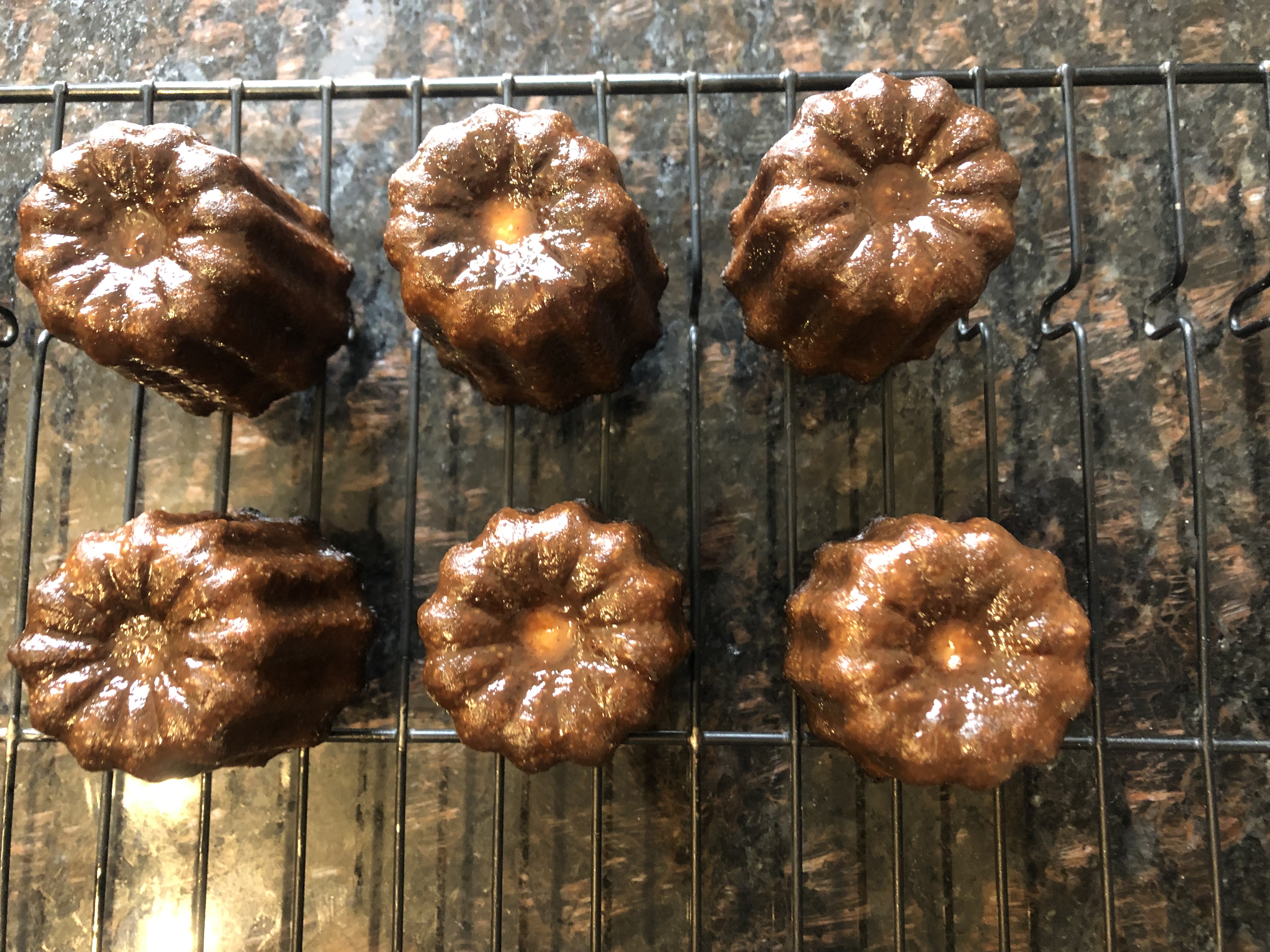
‘Have you ever made canelés?’ (Photo: Marie-Lais Emond)
“Am going to grab a nice pod.” She disappears for a minute. “I’m going to halve my recipe for 12 and we’ll make six. So this will take half a vanilla pod – look at that nice lot of caviar.” So 25 grams of butter, 50 grams of flour and 125 grams of confectioner’s sugar – you know, icing sugar – and 50 grams of beaten eggs and 20g of egg yolks.” The egg yolks are on the scale and with a palette knife Nikita removes part of one yolk till it’s exact. “Canelés are fussy little things.”
Nico goes to a meeting. I imagine he’ll be back more or less when our canelés emerge.
“Now I heat two thirds of the milk. All of it is 250 ml or 1 cup. Keep one third aside, just at room temperature. We put the vanilla seeds and that half pod in and the butter. Give it a stir so the butter melts. And now it heats till just before it bubbles.
“Okay, take it off to cool and we put a plastic sheet over the surface to stop skin forming.” She puts a thermometer in too. It must come down to 80 degrees before we go on.
“For now we sift everything together, that’s the flour and icing sugar. Put that oven on to 220-230℃.
“Meantime I oil the moulds, always with a mixture of beeswax and ghee. It doesn’t transfer to the contents and everything slips out easily. I have this coating mixture I made of 75 grams of beeswax and 75 grams of ghee melted together. So we heat the moulds in the oven that’s 170℃ for five minutes. I warm my mixture also.
“You drop the greasing mixture in the hot moulds. That’s why I’ve got all the towels. You coat it thinly and turn them over to pour it out. Now we put the moulds in the freezer for about 20 minutes.”
The thermometer bleeps. The milk mixture has reached 80℃.
“To the flour and confectioners sugar over there we add the room temperature milk, that third we kept aside. And mix it in. Use the whisk and add the milk mixture, seeds and all. Keep the pod out here. Sometimes the seeds stay behind and I just squash them into the mixture. Hmmm, smells so good. Really whisking in the eggs and egg yolks. Now I’m adding the rum.”
Nikita measures out a tablespoon and a bit of dark rum. “Twenty mls and don’t be shy. Mix that in. All smooth. We’re going to cover this mixture now and keep it in the fridge for 48 hours because I have the other one I’ve already kept for 48 hours, remember.”
She comes back with the other bowl, lifting the covering from that one.
“The mixture changes drastically. The moulds come out of the freezer. “Feel the cold moulds. Don’t fill the mixture right up to the top of the moulds. It rises a bit. They’re going into the oven for 45 minutes. Have some more coffee.”
“If the weather had been different I would have made some double-fold vanilla gelato for us to taste what the best vanilla does.”
Nikita says she’s been really serious, “You know, the eating, sleeping, breathing type of serious’’ about patisserie and cakes for six years. She’d done her City and Guilds culinary courses. “But I’m mostly self taught and my big thing is French patisserie. Most of the things I’ve perfected through experience, like the canelés.”
When they come out I can’t believe how dark and handsome they are. “Now we slip them from the moulds. If canelés cool first – they’re such little devils – they stick like mad. As they cool out of the moulds now, they’ll crisp up and darken some more. The crusts will still go hard.” I’m so excited I want to pinch myself. “I’m going to put them in this little cake box with the lid open so that they can carry on crisping.” Yes. Nikita’s giving the canelé’s to me.
I’ve already decided that Liz and her husband and I are going to have tea together when I get back, and what we’ll have, for her being such a great landlady and for us to appreciate this vanilla as cooked by the wonderfully talented Nikita Suter of Haute Cakes. Liz is a scientist and I know she loves how things work, including food. To this end, apart from the canelés, I have, boxed with a wonderful ribbon the star showpiece, as I see it, of Haute Cakes. It’s an irresistible sounding coffee, pecan, caramel layer cake of 12 layers. It’s like the vanilla works, with cocoa sponge, caramelised pecan crunch and a vanilla-speckled coffee-caramel mousse within. It’s a looker too, but incidentally, with what Nikita calls a chocolate cuff, this one white chocolate with brown chocolate leopard spots. On top glint Valrhona chocolate pearls.
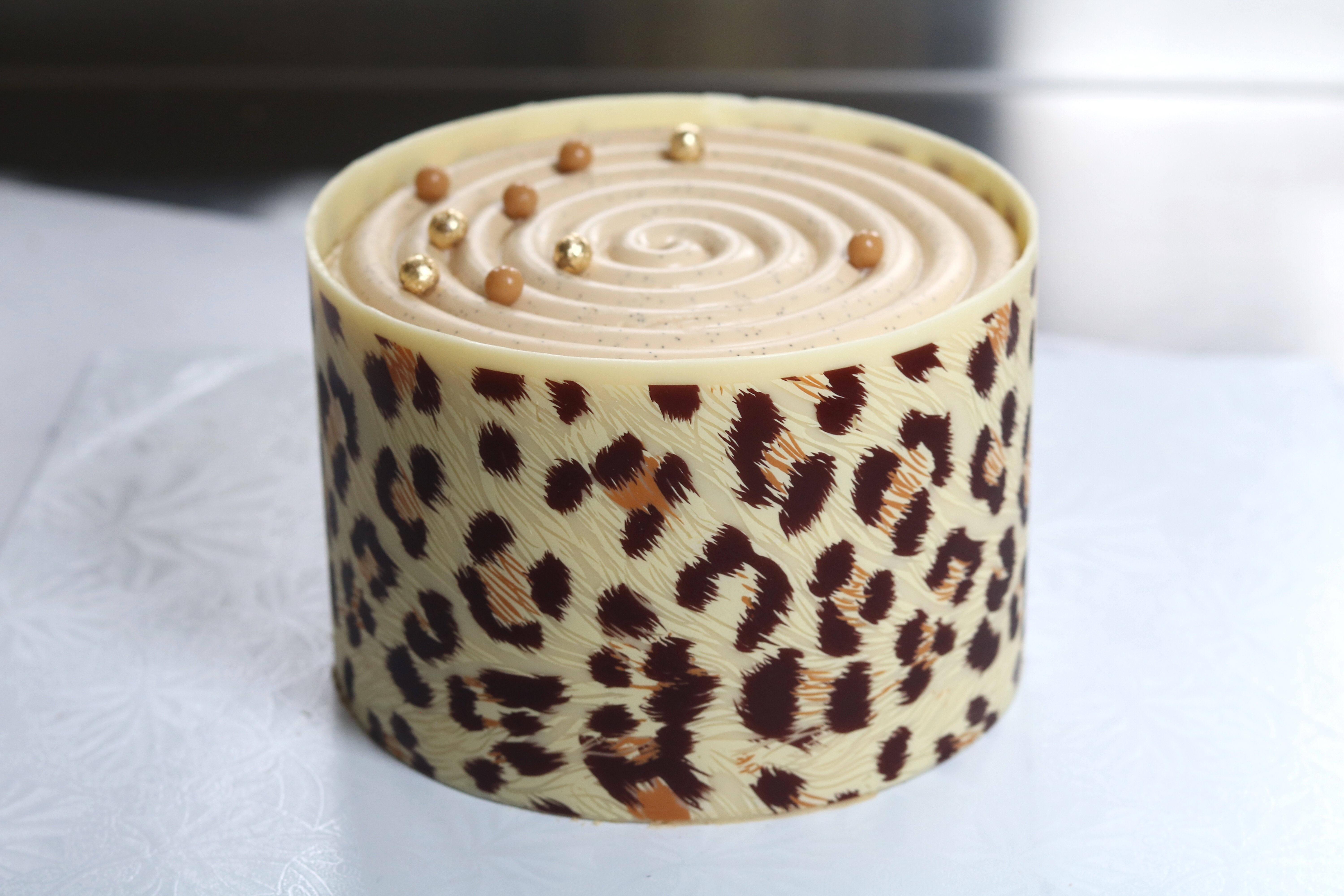
It’s like the vanilla works. There’s cocoa sponge, caramelised pecan crunch and a vanilla-speckled coffee-caramel mousse within. (Photo: Supplied)
It’s like the vanilla works. There’s cocoa sponge, caramelised pecan crunch and a vanilla-speckled coffee-caramel mousse within. (Photo: Supplied)
For good measure, as I leave, Nikita bundles in a vanilla Flan Parisienne, with that outstanding tart crust I tasted earlier, on the crème brûlée piece.
“Like a vanilla cheesecake only softer and more special,” coos Liz about it back home. We lick our fingers.

The vanilla Parisian Flan, with that outstanding tart crust I tasted earlier. (Photo: Supplied)
Liz’s husband Klaus is still in his rooms. He’s a doctor so she and I try everything first, before he gets his.
“This caramelly hazelnutty crunch!” says Liz in admiration. It’s one of the layers of our spotted layer cake.
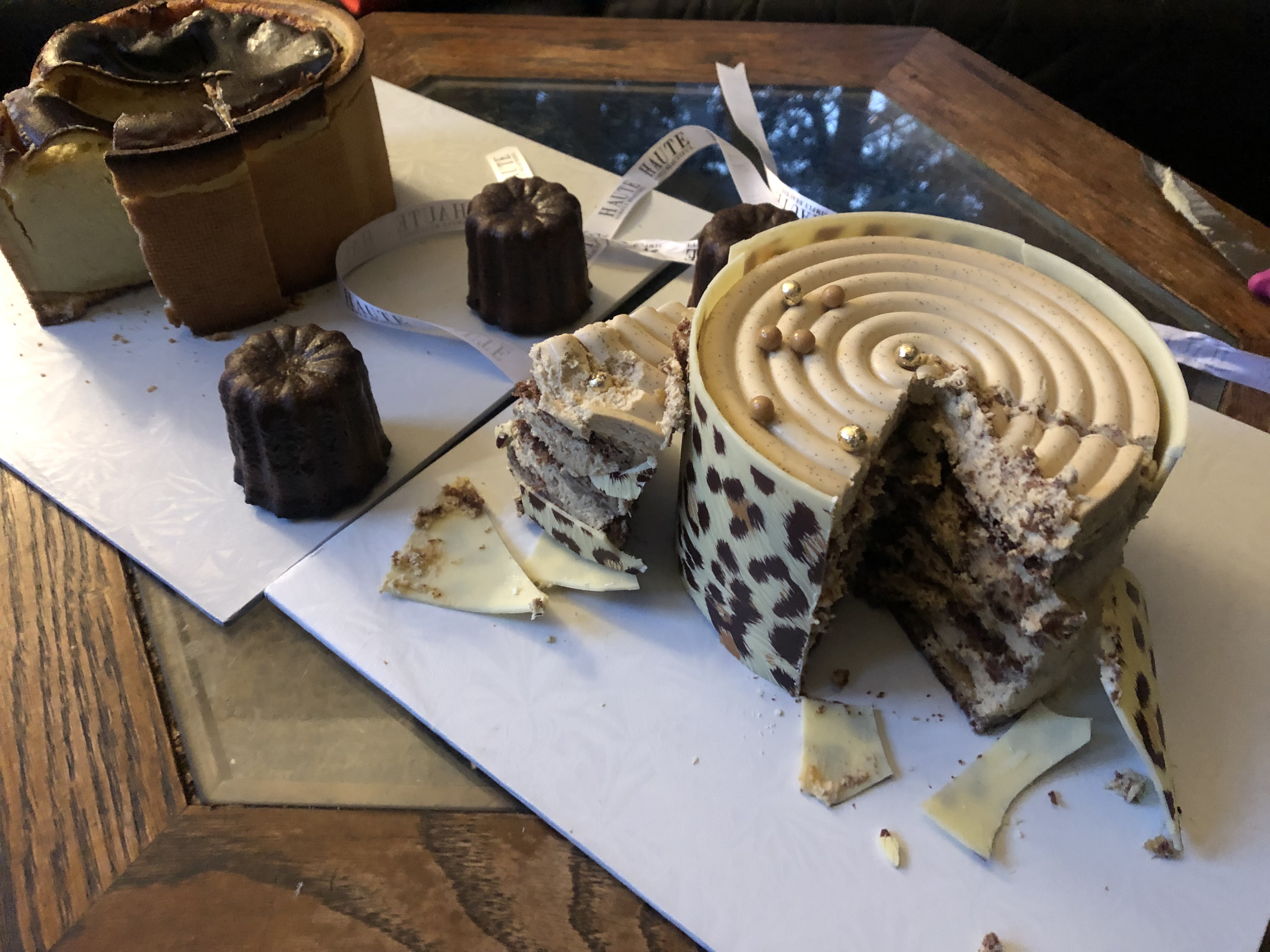
My landlady and I try everything first, before her husband gets his. (Photo: Marie-Lais Emond)
We gaze adoringly at the canelés. “I won’t tell Klaus about these – you keep all the others for yourself. What a find this baker is. But so’s the vanilla, I think.”
The perfect vanilla. The ultimate pod of desire. Without it and the necessary acquisition of a few copper moulds, how would I show off? DM/TGIFood
More about Nilla Vanilla and Haute Cakes on these links
The writer supports Nosh Food Rescue, an NGO that helps Jozi feeding
schemes with food ‘rescued’ from the food chain. Please support them here.





 Become an Insider
Become an Insider
Comments - Please login in order to comment.